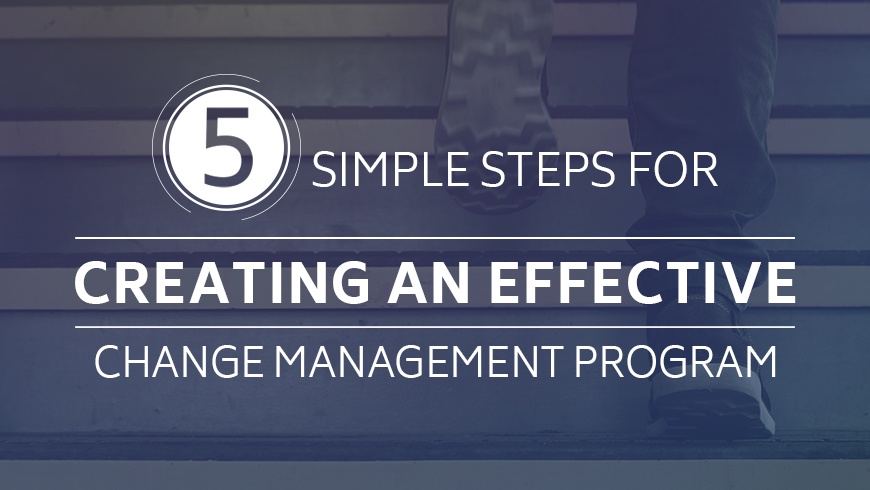5 Steps for Effective Change Management
Compliance and Certification | Education
Published: Aug 4, 2016
Last Updated: Oct 18, 2023
Identifying changes that must be made is the easy part. Managing those changes successfully—not so simple! Organizations today need to be extraordinary at adapting to or influencing changes in technology, policy, and procedure. Those who adjust well aren’t phased by the fast pace of the market or the constant evolutions in technology and security standards. Those who struggle with change constantly operate in a reactive state, and fail to properly strategize their business moves.
We get it—change isn’t always easy. But if you have an effective change management program in place, it doesn’t need to be hard, either. A change management program involves a process, tools, and techniques to manage the people side of change. Here are five simple steps for creating an effective change management program that empowers your organization to adapt safely, simply, and in a way that ensures compliancy with industry standards.
1. Get Executive-Level Buy-In
You need more than just a thumbs up to get your change management program off the ground. Executive-level buy-in means true support from the leaders in your organization. Get them to see the dangers of unauthorized changes and ask for their backup in enforcing consequences when change management protocols aren’t followed by employees. It’s the best way to ensure your entire workforce takes the initiative seriously and understands why it’s important.
2. Think Proactive, Not Reactive
Every great leader knows that the worst thing you can do when something doesn’t go according to plan is react without thinking. Therefore, your first step in change management is a shift in the way you and your organization see change. Instead of immediate action, condition your workforce to analyze the “bigger picture”: Why is change necessary? Who will this change affect? What will be required to successfully make the change?
This is the perspective you want to adopt early on. A mental shift in the way you look at and respond to instances of change will set the foundation for your entire program.
3. Know Your Infrastructure
Have a working knowledge of all your assets and how they influence one another and the organization at large. Prioritize them based on how critical they are to the overall operation and what types of risk they present should something inhibit their proper function or utilization.
4. Document a Step-by-Step Process
The key to creating a change management process is making it simple and concise enough for all employees to follow. You want the process to be repeatable and flexible so that it can be followed no matter what change is being made and in a short timeframe, when needed. You also want it to be simple enough that anyone who is authorized to make a change can follow the protocol successfully. As you build out this process, be sure to include an emergency plan of action for unexpected change requests. Some necessary steps include:
- Preparing for change: Identify your change management team. Specify their exact duties and inform the employees or departments that will be directly affected by the change.
- Managing the change: Map out specific plans, establish forms of communication, identify challenges, and scheme how they will be addressed and resolved.
- Reinforcing the change: Gather and scrutinize data. This could be done by passing out pre/post-change surveys or speaking with individuals who strongly oppose the change. Implement remedial actions if the feedback deems it necessary.
5. Fortify Your Change Management Program
Once all the necessary tools and processes are in place, communicate the details of the program to your entire workforce. Make certain they know where to find a SOP on the process if needed, and let it be known that failure to comply with the change process will result in consequences. Once again, input from upper-level management will help send a clear message that your change management program is not an option.
We’ll say it again: change isn’t always easy. But with the right tools, processes, and support in place, it is possible to empower your organization to be highly adaptable without jeopardizing compliancy with your industry’s mandatory standards. Follow these simple steps and start building a successful change management program today.
About DEBBIE ZALLER
Debbie Zaller is Chief Operating Officer at Schellman. Debbie is responsible for maintaining and driving operational results and executing the firm's strategic goals. Debbie oversees all daily operations of the firm while spearheading the development, communication and implementation of effective growth strategies and processes. Debbie has over 21 years of IT compliance and attestation experience. Debbie led the firm's Midwest, Southeast, and Northeast regions along with the national service lines of SOC 2 and Privacy service lines as Managing Principal before assuming the position of COO in 2021. Debbie holds a Master of Accounting degree from the University of Florida. She is a Certified Public Accountant, Certified Information Privacy Professional/United States, Certified Data Privacy Solutions Engineer, Certified Information Systems Security Professional, Certified Information Systems Auditor, and Certified Cloud Security Knowledge. She is currently an AICPA-approved and nationally listed SOC Specialist and speaker on various privacy topics. Debbie was on the AICPA Task Force for the Advanced SOC for Certification Exam, was a member of the Florida Institute of Certified Public Accountants Board of Governors and served on the Finance and Office Advisory Committee.




